Queensland |
||||||||||||||||||||||||||||||||||||||||||||||||||||||||||
 |
 |
|||||||||||||||||||||||||||||||||||||||||||||||||||||||||
Crocheted dress with raglan, lace pattern and short sleeves, worked top down. Sizes S - XXXL. The piece is worked in DROPS Safran.
DROPS 186-12 |
||||||||||||||||||||||||||||||||||||||||||||||||||||||||||
|
INFORMATION FOR THE PATTERN: CROCHET INFO: On beginning of each round with treble crochets replace first treble crochet with 3 chain stitches. The round finishes with 1 slip stitch in the 3rd chain stitch at the beginning of the round. INCREASE/DECREASE TIP (evenly spaced): To work out how to increase/decrease evenly, count the total number of stitches on the round (e.g. 114 stitches) and divide by the number of increases/decreases to be made (e.g. 29) = 3.9. In this example, increase in approx. every 4th stitch – read INCREASE TIP. When decreasing, crochet every 3rd and 4th stitch together – read DECREASE TIP. INCREASE TIP: Increase 1 treble crochet by working 2 treble crochets in the same stitch. DECREASE TIP: Decrease 1 treble crochet by working the next 2 treble crochets together as follows: Work 1 treble crochet, but wait with the last yarn over and pull through (= 2 loops on hook), work the next treble crochet, but when working the last pull through, pull the strand through all 3 loops on the hook. PATTERN: See diagrams A.1 to A.5. ---------------------------------------------------------- DRESS: The piece is worked in the round, top down. NECK: Work 114-118-124-128-132-136 slightly loose chain stitches with hook size 3.5 mm and Safran and form them into a ring with 1 slip stitch in the first chain stitch. ROUND 1: Work 2 chain stitches (equivalent to 1 half treble crochet), then work 1 half treble crochet in each chain stitch to end of round, finish the round with 1 slip stitch in the 2nd chain stitch at the beginning of the round = 114-118-124-128-132-136 half treble crochets. ROUND 2: Work 3 chain stitches (equivalent to 1 half treble crochet + 1 chain stitch), skip 1 half treble crochet, * work 1 half treble crochet in the next half treble crochet, 1 chain stitch, skip 1 half treble crochet *, work from *-* to end of round and finish with 1 slip stitch in the 2nd chain at the beginning of the round = 114-118-124-128-132-136 stitches on round. ROUND 3: Work 3 chain stitches (equivalent to 1 treble crochet), then work 1 treble crochet in each half treble crochet and 1 treble crochet around each chain stitch – AT THE SAME TIME increase 29-25-30-26-33-29 treble crochets evenly on round – read INCREASE/DECREASE TIP and INCREASE TIP = 143-143-154-154-165-165 treble crochets. Finish the round with 1 slip stitch in the 3rd chain stitch at the beginning of the round. Read CROCHET INFO and work A.1 in the round (= 13-13-14-14-15-15 repeats of 11 stitches). On the last round in A.1 you will, for the most part, work 15 treble crochets in each repeat, but in 5-5-6-10-7-11 repeats evenly spaced on the round, increase this to 16 treble crochets so that the total is 200-200-216-220-232-236 treble crochets on the round. The piece now measures approx. 7 cm from the cast-on edge. Now work yoke as described below. REMEMBER THE CROCHET TENSION! YOKE: Work 1 round of treble crochets with 1 treble crochet in each treble crochet. Then insert 4 marker threads in the piece as follows (without working the stitches): Count 34-34-38-39-42-43 treble crochets (= ½ back piece), insert 1 marker thread in the next treble crochet, count 30 treble crochets (= sleeve), insert 1 marker thread in the next treble crochet, count 68-68-76-78-84-86 treble crochets (= front piece), insert 1 marker thread in the next treble crochet, count 30 treble crochets (= sleeve), insert 1 marker thread in the next treble crochet. There are 34-34-38-39-42-43 treble crochets left on the round after the last treble crochet with marker thread. Continue working treble crochets in the round with 1 treble crochet in each treble crochet - AT THE SAME TIME increase to raglan at each marker thread as follows: ROUND 1: Work 1 treble crochet + 2 chain stitches + 1 treble crochet in each treble crochet with a marker thread (= 4 treble crochets increased on the round) = 204-204-220-224-236-240 treble crochets on the round. ROUND 2: Around each chain-space with 2 chain stitches work 1 treble crochet + 2 chain stitches + 1 treble crochet (= 8 treble crochets increased on round) = 212-212-228-232-244-248 treble crochets on round. Repeat round 2 until you have worked a total of 9-13-15-18-20-23 rounds with increases (including the increases in round 1) = 268-300-332-360-388-416 treble crochets on the round. On the next round work 1 treble crochet in each treble crochet, but around each chain-space with 2 chain stitches work 2 treble crochets (= 8 treble crochets increased on the round) = 276-308-340-368-396-424 treble crochets on the round. Continue to work treble crochets without increases until the piece measures 19-21-23-25-27-29 cm from the cast-on edge mid front. The next round is worked as follows: Work 40-44-48-53-59-65 treble crochets (including the 3 chain stitches at beginning of round = ½ back piece), work 8-8-10-10-12-14 slightly loose chain stitches, skip 58-66-74-78-80-82 treble crochets (= sleeve), work 80-88-96-106-118-130 treble crochets (= front piece), work 8-8-10-10-12-14 slightly loose chain stitches, skip 58-66-74-78-80-82 treble crochets (= sleeve) and work the last 40-44-48-53-59-65 treble crochets on the round (= ½ back piece). Cut the strand. Body and sleeves are finished separately. THE PIECE IS NOW MEASURED FROM HERE! BODY: Insert 1 marker in the middle of the 8-8-10-10-12-14 chain stitches under the sleeve on the one side of the piece and start the round here. Work 1 double crochet in the first chain stitch, 3 chain stitches (equivalent to 1 treble crochet), then work 1 treble crochet in each chain stitch and 1 treble crochet in each treble crochet to end of round = 176-192-212-232-260-288 treble crochets. Continue in the round with treble crochets. When the piece measures 2 cm from the separation, decrease 8-8-8-10-10-10 treble crochets evenly on round = 168-184-204-222-250-278 treble crochets – read INCREASE/DECREASE TIP. Repeat the decrease when the piece measures 6 cm from the separation = 160-176-196-212-240-268 treble crochets. When the piece measures 12 cm from the separation, increase 12-12-12-14-14-14 treble crochets evenly on round = 172-188-208-226-254-282 treble crochets. When the piece measures 18 cm from the separation, increase 12-12-12-14-14-14 treble crochets evenly on round = 184-200-220-240-268-296 treble crochets. When the piece measures 26 cm from the separation, increase 14 treble crochets evenly on round in all sizes = 198-214-234-254-282-310 treble crochets. When the piece measures 34 cm from the separation, increase 14 treble crochets evenly on round in all sizes = 212-228-248-268-296-324 treble crochets. When the piece measures 40-41-42-43-44-45 cm from the separation, (the piece now measures approx. 62-65-68-71-74-77 cm from the shoulder) increase 40-48-40-44-40-48 treble crochets evenly on round = 252-276-288-312-336-372 treble crochets. Work A.2 in the round (= 21-23-24-26-28-31 repeats of 12 stitches). AT THE SAME TIME on the last round in A.2 increase 52-60-64-72-64-60 treble crochets evenly on round = 304-336-352-384-400-432 treble crochets. Work A.3 in the round (= 19-21-22-24-25-27 repeats of 16 stitches). When A.3 has been completed, there are 475-525-550-600-625-675 treble crochets on the round. Now work A.X as shown in A.2 (= 2 rounds). AT THE SAME TIME on the last round increase 30-28-39-25-36-34 treble crochets evenly on round = 505-553-589-625-661-709 treble crochets. The next round is worked as follows: A.4A (= 6 stitches), work A.4B over the next 492-540-576-612-648-696 treble crochets (= 41-45-48-51-54-58 repeats of 12 stitches), finish with A.4C (= 7 stitches). When A.4 has been completed, cut and fasten the strand. The dress measures approx. 92-95-98-101-104-107 cm from the shoulder down. SLEEVE: Insert 1 marker in the middle of the 8-8-10-10-12-14 chain stitches under the sleeve on the one side of the piece and start the round here. Work 1 double crochet in the first chain stitch, 3 chain stitches (equivalent to 1 treble crochet), then work 1 treble crochet in each chain stitch and 1 treble crochet in each treble crochet to end of round = 66-74-84-88-92-96 treble crochets. Work 1 round of treble crochets where you decrease 6-2-12-4-8-0 treble crochets evenly on round = 60-72-72-84-84-96 treble crochets. Work A.5 in the round (= 5-6-6-7-7-8 repeats of 12 stitches). When there are 3 rounds left in A.5 change to hook size 3 mm. Finish working A.5, cut and fasten the strand. The sleeve measures approx. 8 cm from the separation. Work the other sleeve in the same way. |
||||||||||||||||||||||||||||||||||||||||||||||||||||||||||
Diagram explanations |
||||||||||||||||||||||||||||||||||||||||||||||||||||||||||
|
||||||||||||||||||||||||||||||||||||||||||||||||||||||||||
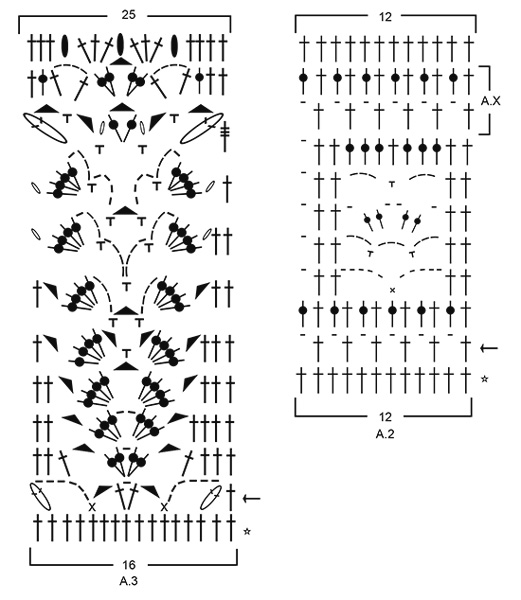
|
||||||||||||||||||||||||||||||||||||||||||||||||||||||||||
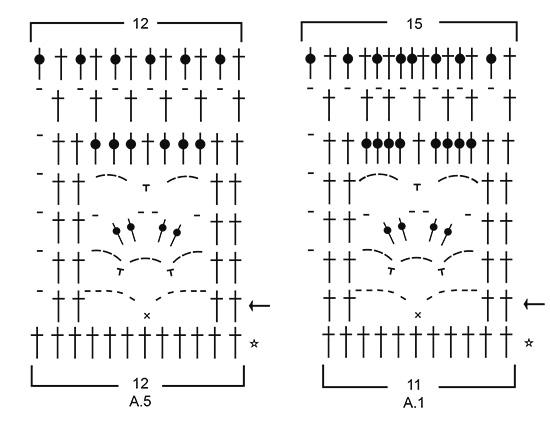
|
||||||||||||||||||||||||||||||||||||||||||||||||||||||||||

|
||||||||||||||||||||||||||||||||||||||||||||||||||||||||||
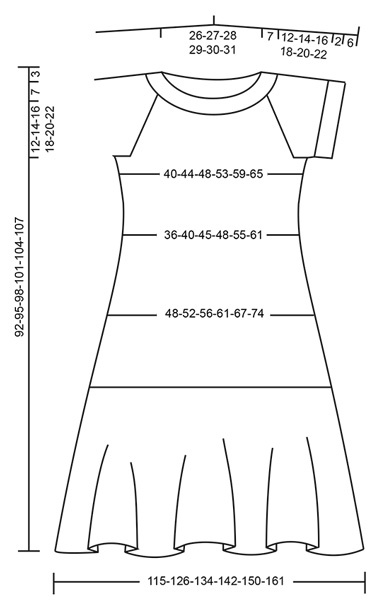
|
||||||||||||||||||||||||||||||||||||||||||||||||||||||||||
|
Have you made this or any other of our designs? Tag your pictures in social media with #dropsdesign so we can see them! Do you need help with this pattern?You'll find tutorial videos, a Comments/Questions area and more by visiting the pattern on garnstudio.com. © 1982-2024 DROPS Design A/S. We reserve all rights. This document, including all its sub-sections, has copyrights. Read more about what you can do with our patterns at the bottom of each pattern on our site. |
||||||||||||||||||||||||||||||||||||||||||||||||||||||||||

































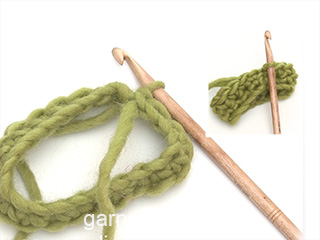
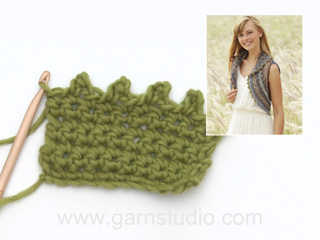























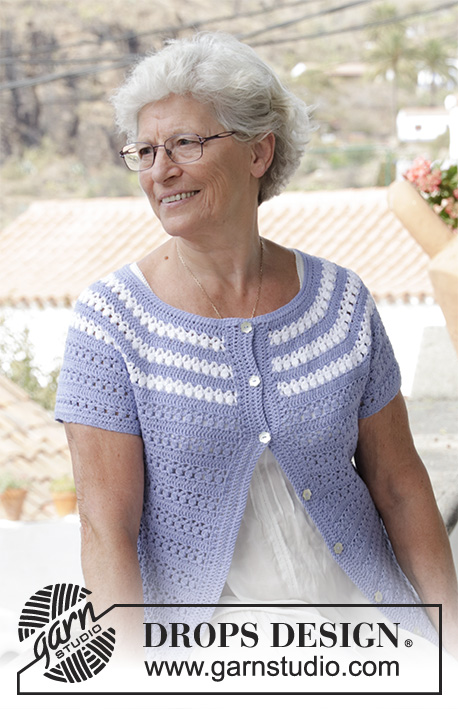
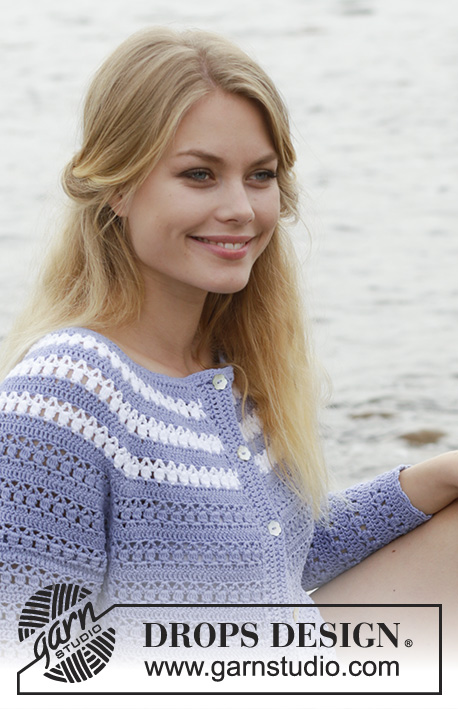






Comments / Questions (60)
Hallo, ich habe meinen Fehler gefunden, aber trotzdem danke für die schnelle Antwort.
09.03.2021 - 18:46Hallo, bei der Passe soll man Stäbchen ohne Zunahme häkeln, häkelt man hier die Luftmaschen über den Markierungen. Vielen Dank.
08.03.2021 - 19:52DROPS Design answered:
Liebe Frau Nelket, wo sind Sie jetzt genau bei der Passe, welche Runde meinen Sie? Können Sie uns etwas mehr sagen, so kann man Ihnen am besten helfen. Danke für Ihr Verständnis.
09.03.2021 - 07:56J'ai fait l'échantillon avec crochet n"3 au lieu de 3,5 et je suis arrivée aux mêmes dimensions. Par contre J'ai respecte toutes les données du modèle et sous les emmanchures J'ai 10 cms en trop en largeur.. Je ne comprends pas. Merci de m'aider. Bonne soiree
08.11.2020 - 18:32DROPS Design answered:
Bonjour Mme Hugue, vérifiez si vous avez bien votre nombre de mailles, si vous avez bien conservé la même tension que pour votre échantillon; avec 22 brides = 10 cm, vous devez avoir 176-192-212-23-260-288 m = 40-44-48-53-59-65 cm (posé à plat, comme dans le schéma). Bon crochet!
09.11.2020 - 11:21I really need help. this section "Read CROCHET INFO and work A.1 in the round (= 13-13-14-14-15-15 repeats of 11 stitches). On the last round in A.1 you will, for the most part, work 15 double crochets in each repeat, but in 5-5-6-10-7-11 repeats evenly spaced on the round, increase this to 16 double crochets so that the total is 200-200-216-220-232-236 double crochets on the round" does really not make ANY sence. I don't understand what it means, please help
03.10.2020 - 21:51DROPS Design answered:
Dear Angiee, on the last round in A.1 you have to crochet 15 dc in each A.1 (see diagram) but on this round you have to increase evenly, this means that over some repeats of the round (= 5-5-6-10-7-11 repeats) you will crochet 16 dc instead of 15 dc - you will then incraese a total of 5-5-6-10-7-11 sts; there were 13-13-14-14-15-15 repeats with 11 sts each, you will have now 8-8-8-4-8-4 repeats with 15 sts each + 5-5-6-10-7-11 repeats with 16 sts each = 200-200-216-220-232-236 sts. Happy crocheting!
05.10.2020 - 10:15Good day, I am trying to figure out how many 50 g of Drops Safran I need for size L or XL. The pattern does not indicated it and I want to make sure I have enough to finish the dress.
20.04.2020 - 18:53DROPS Design answered:
Dear Lorraine, for amount of yarn see header nearby main picture: Sizes: S - M - L - XL - XXL - XXXL Materials: DROPS SAFRAN from Garnstudio (belongs to yarn group A) 700-750-800-900-1000-1050 g colour 05, light blue purple Number of amount goes in the same order as letter for sizing, so for size L-XL you need 800-900 g of Safran. If you divide this amount 50 g, you will get number of balls (16-18). Happy crocheting!
20.04.2020 - 19:48Hallo liebes Team , ich weiß leider nicht wie folgendes gemeint ist : In der letzten Runde von A.1 zunächst 15 Stäbchen in jedem Rapport häkeln, aber in 5-5-6-10-7-11 Rapporten gleichmäßig verteilt in der Runde auf 16 Stäbchen zunehmen, sodass insgesamt 200-200-216-220-232-236 Stäbchen in der Runde sind. Dort komme ich nicht weiter
01.01.2020 - 13:54DROPS Design answered:
Liebe Sarah, bei der letzten Reihe in A.1 hat man normaleweise 15 Stäbchen in jedem Rapport, aber wenn Sie dann diese Reihe häkeln, sollen Sie regelmäßig zunehmen, dh in 5-5-6-10-7-11 Rapporte häkeln Sie 16 Stäbchen (anstatt 15) und in den übrigen Rapporte häkeln Sie 15 Stäbchen wie im Diagram gezeigt. hier lesen Sie mehr wie man gleichmäßig verteilt zunimmt. Viel Spaß beim häkeln!
02.01.2020 - 15:18Hva er konsekvensene av at man ikke har begynt omgangene i bærestykket med tre luftmasker og avsluttet med kjedemaske i 3.luftmaske? Kan dette eventuelt rettes opp uten å rekke opp alt? Hvordan gjøres det i så fall?
27.10.2019 - 21:10DROPS Design answered:
Hei Liza. I denne oppskriften starter man med 3 luftmasker som erstatter 1 stav på omgangen, slik kommer du deg opp i "høyden". Om du har startet med en stav, kan du få en liten "bulk" når du skal avslutte omgangen med 1 kjedemasken i denne staven. Du vil også få en stav for liten når du skal telle over maskeantallet, siden de 3 luftmaskene erstatter en stav. mvh DROPS design
28.10.2019 - 14:01Hello!! Could you please tell me what is meant by "Cast-on edge mid front"??
16.06.2019 - 17:49DROPS Design answered:
Dear Anjana, this means that you measure your piece from the very first row = cast-on edge and in the middle of front piece, because it is the lower point of neck (back piece has higher neck, so the measurement will be different). Happy crocheting!
16.06.2019 - 18:26Could you please explain or write for me Diagram A.4A, A.4B and A.4C Rows: 7 and 8 only. I am having real hard time to understand or follow the diagram. I have put it away for awhile thinking I could try it later but am stuck here. The dress for Mom is almost done. Please help, my doubt are were it says do single crochet in the stitch, which stitch? the double crochet from previous row? or on the 4 double crochet together from previous row? Thank you.
18.05.2019 - 01:02DROPS Design answered:
Dear Mrs Morales, the "sc in stitch" should be worked at the top of the 4 double crochet worked together on previous row - on row 7. Happy crocheting!
20.05.2019 - 14:20How do you down patterns for printing?
01.04.2019 - 19:09DROPS Design answered:
Dear Mrs Kuppinger, click on the icon with the printer/pattern, a new window will open, in that new window click on "Continue to print the pattern" to launch printing. Happy crocheting!
02.04.2019 - 09:36